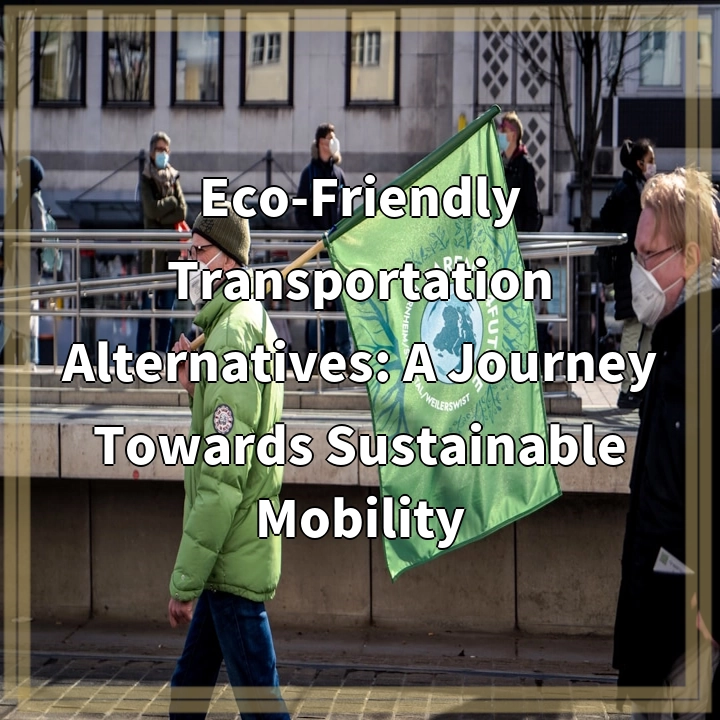
What is Eco-Friendly Transportation Alternatives?
Eco-Friendly Transportation Alternatives refer to the various modes of transportation that aim to minimize negative environmental impacts while meeting the mobility needs of individuals and communities. Unlike traditional transportation methods that heavily rely on fossil fuels and contribute to air pollution, excessive greenhouse gas emissions, and traffic congestion, eco-friendly alternatives prioritize sustainability, energy efficiency, and reduction of carbon footprint.
Real-World Problems
Eco-friendly transportation alternatives face several challenges and obstacles as they strive to transform the way we move. These problems include:
1. Limited Infrastructure
The lack of appropriate infrastructure for eco-friendly transportation, such as dedicated bike lanes, charging stations for electric vehicles, and efficient public transportation networks, hinders the widespread adoption of sustainable mobility options. Inadequate infrastructure discourages people from choosing eco-friendly alternatives and promotes continued reliance on conventional fossil fuel-based transportation.
2. Cost Barriers
Many eco-friendly transportation options, such as electric cars or bicycles, can come with a higher upfront cost compared to their traditional counterparts. This affordability barrier may limit access and adoption, particularly for low-income individuals or those living in areas with limited financial resources.
3. Limited Accessibility
In some regions, eco-friendly transportation alternatives may not be easily accessible or available to everyone. This can be due to a lack of public transportation services, limited bike-sharing programs, or insufficient infrastructure for pedestrians and cyclists. The limited accessibility creates transportation inequalities and restricts the choices available for individuals who want to opt for sustainable alternatives.
4. Behavioral Resistance
Changing ingrained transportation habits and behaviors can be a significant challenge. Sometimes, individuals are resistant to adopting eco-friendly transportation alternatives due to personal preferences, convenience, or lack of awareness about the environmental benefits of sustainable mobility. Overcoming this resistance and fostering a mindset shift towards sustainable transportation is an ongoing challenge.
5. Transition to Renewable Energy
While eco-friendly alternatives like electric vehicles contribute to reducing greenhouse gas emissions, the transition from conventional vehicles to electric vehicles requires managing the shift to renewable energy sources. The reliance on electricity generated from fossil fuels can limit the environmental benefits of electric vehicles. An effective transition to renewable energy for powering eco-friendly transportation is crucial for achieving sustainable mobility goals.

Solutions for Eco-Friendly Transportation Alternatives
In order to address the real-world problems associated with eco-friendly transportation alternatives, the following solutions can be implemented:
1. Infrastructure Development
The expansion and improvement of infrastructure are essential for promoting sustainable transportation. This includes the creation of dedicated bike lanes, the construction of charging stations for electric vehicles, and the enhancement of public transportation networks. By investing in infrastructure, cities and communities can encourage the adoption of eco-friendly transportation options and provide convenient and safe alternatives to conventional modes of travel.
2. Financial Incentives and Affordability
To overcome the cost barriers associated with eco-friendly transportation, governments and organizations can offer financial incentives such as tax credits or subsidies for purchasing electric vehicles or installing renewable energy charging stations. Making eco-friendly alternatives more financially accessible through affordable loan programs or subsidies can help lower-income individuals and communities embrace sustainable mobility options.
3. Improved Accessibility and Equity
The focus should be on ensuring that eco-friendly transportation alternatives are accessible to all individuals, regardless of their location or socio-economic status. This can be achieved by expanding public transportation networks to underserved areas, implementing bike-sharing programs in suburban and rural communities, and creating pedestrian-friendly environments. Prioritizing accessibility and equity in transportation planning can provide equal opportunities for everyone to choose sustainable mobility options.
4. Education and Awareness
Increasing awareness about the environmental benefits of eco-friendly transportation is crucial for changing behavior and overcoming resistance. Educational campaigns, public outreach programs, and initiatives that highlight the positive impacts of sustainable mobility can inspire individuals to consider and choose eco-friendly transportation alternatives. Public awareness campaigns can play a significant role in fostering a more sustainable transportation culture.
5. Renewable Energy Transition
In tandem with promoting eco-friendly transportation, there needs to be a shift towards renewable energy sources to power these alternatives. Investing in renewable energy infrastructure, such as solar-powered charging stations, can ensure that the environmental benefits of eco-friendly transportation are maximized. Transitioning to clean and sustainable energy sources will further reduce carbon emissions and support the overall goal of sustainable mobility.















